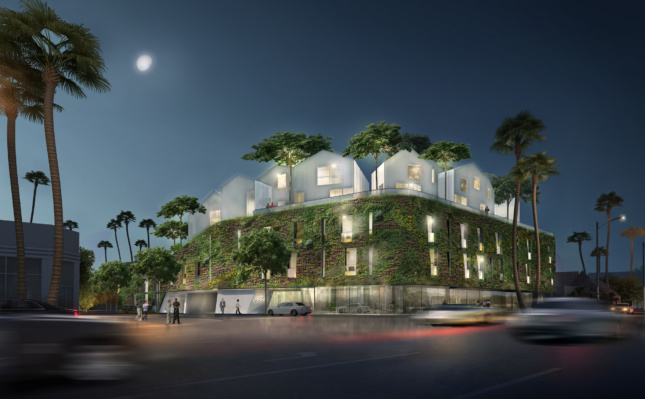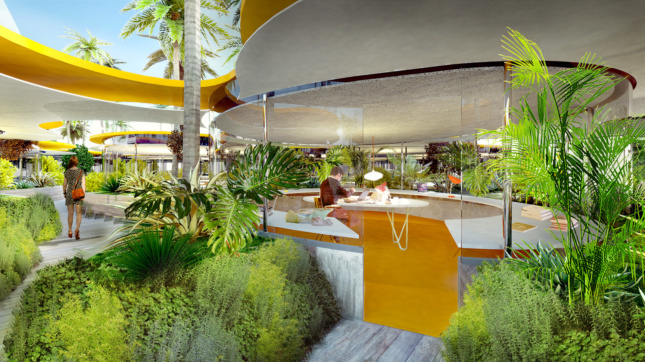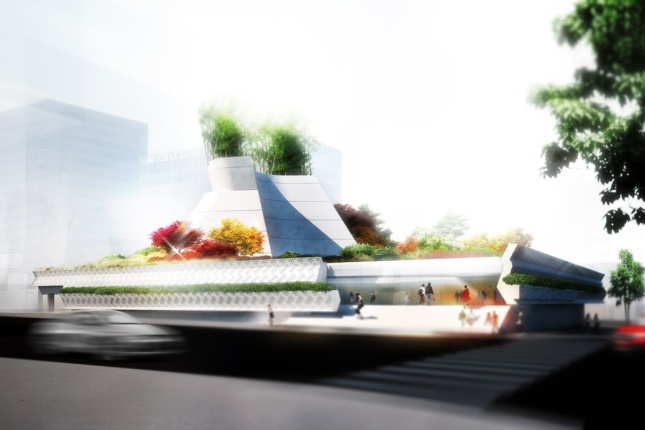Makin’ my way downtown, I zip along on my Lime® scooter through the ersatz Japanese village of Little Tokyo, past taxis, buses, and Prii, to a bustling, small-scale warehouse district on the fringe of Los Angeles’s central core. The whirlwind of scales, land uses, languages, and people is dizzying, but I finally land at my destination: Sonoratown, a lively taco spot famous for its soft tortillas, which are made with flour driven up from Sonora, Mexico, in small batches by the owner’s mom.
This delirious, quasi-urban experience is one that could only happen in the messy, diverse urban fabric of Los Angeles. You are free to grab whatever pieces of the kaleidoscopic surroundings you can, and the faster you are moving, the more there is to take. Somehow, this frantic energy and free movement seem unaffected or held back by the past. The cultural critic Sean Monahan called LA the capital of the 2010s, describing it as:
…a city whose attributes anticipate collapse: flat and amorphous, rather than vertical and defined; kitsch and pop, rather than avant-garde and tech; individualistic and mass, rather than institutional and elite. You can suggest San Francisco, HQ of disruption, or New York, backdrop for protest movements (#OWS, #BLM). But both places fail to capture the spirit of the age, because they are fighting so hard to change it. They are relics of empire, unsure of themselves after a decade in which success was indistinguishable from failure…
Built on celebrity, media, and lifestyle, L.A. doesn’t presume to be building the future, merely inhabiting it. It’s a pick your poison kind of place. [Go wild] at Chateau Marmont. Spend half your paycheck on inscrutable health food at Erewhon. Commute four hours so you can live in a Riverside McMansion. Drive Uber every day, write screenplays every night. Sell out, drop out, suck up, fuck up. There is no right or wrong way to do L.A.
Monahan accurately describes why Los Angeles encapsulates the present, and why it’s the most exciting place in the US right now. However, it is also important to note where the city is moving in the 2020s. With the 2028 Olympics as a finish line, Los Angeles is at a crossroads, on a path to become a different place in the next decade. But with the city already at the forefront of global media culture (The Kardashians, Moon Juice, Goop, etc.), it doesn’t need global architecture to maintain its position as a worldwide force. How it defines itself as a physical place is still up for grabs, and it should learn lessons from other hyper-globalized cities, namely New York.

Tomorrow’s Los Angeles is one of layers. Moving on from its days as a bastion of mythological American modernism centered around mobility (cars), individuality (single-family homes), and triumph over nature (lawns), it will add new collectivities on to itself. These layers will arise from the constant flux of the new: Technologies and emerging social patterns meld nicely into the loose, still-codifying culture and its corresponding urban forms. It is the flickering of new, communal, car-free, publicly subsidized lifestyles against the old, car-centric, low-density, low-regulation, “libertarian” bones of the urban landscape that make it such an interesting place for urbanism today. The oft-bandied-about claim that the city is libertarian is also not entirely accurate, as California is a sea of regulation and red tape, continually votes to raise its already high taxes, and both California and Los Angeles are leading on climate action.
The city is quietly building public infrastructure at a pace that vastly outpaces New York. New York’s Second Avenue Subway took somewhere between 10 and 100 years to complete three stations, and the next phase will be three stops and will be completed by 2029 at the earliest. Meanwhile Los Angeles is (optimistically) on course to build 28 new lines by 2028. This includes an airport-connection line that will allow a direct link from LAX to the city. Meanwhile, New York’s MTA is in a worsening crisis with crumbling stations and delays only getting worse, and New Jersey’s NJ Transit recently gave up on accounting for the traffic expected to reach the American Dream Mall, instead calling on private industry to complete the line, citing none other than Los Angeles’s electric rail airport connector as an example. That’s right—L.A. is leading the way in public transit. Meanwhile, Uber, a municipal car share and micro-mobility options such as scooters have already altered how people get around (many young people don’t have cars at all) and where they live, partly due to an explosion in transit-oriented development around the new metro lines. It is unclear exactly how successful, affordable, and sustainable this will be, but change is certainly underway.
New transit networks both public and private, along with lower parking requirements for new construction will profoundly impact development and housing typologies in the future. But it is no secret that Los Angeles is careening toward a New York–like affordability crisis (if it isn’t there already) that goes hand-in-hand with the urban whitewash of global capital. Homelessness is at record levels and only getting worse. In response, architects are working to develop new housing typologies, from affordable prototypes and accessory dwelling units, to larger, multi-family schemes that continue to evolve with new regulations and design challenges. The L.A. River and the L.A River Greenway in the San Fernando Valley are also emerging sites of urban experimentation and reclamation/rehabilitation of greenspace.

Los Angeles has a unique architectural culture and urban fabric, but red flags are emerging. First, Bjarke Ingels Group and Herzog & de Meuron, international firms that are both very popular with the New York development community, have projects downtown. Related Group (of Hudson Yards fame) has moved in and is developing a large Frank Gehry project across from Gehry’s own Disney Concert Hall. It perfectly illustrates the lower design quality of developer-led construction and echoes Related Companies’ other project, Hudson Yards: “The project is anchored by a central plaza wrapped with shopping areas and public art.”
The biggest red flag might be the shortlist for the La Brea Tar Pits project. In Miracle Mile’s Museum Row, a neighborhood that already has been marred by architectural globalists—once by KPF and twice by Renzo Piano—the shortlist for the La Brea master plan is New York establishment firms WEISS/MANFREDI and Diller Scofidio + Renfro, along with Danish firm Dorte Mandrup. It is a truly odd and troubling list. All three are talented firms, but their selection signals the wind turning toward a placeless architecture where, in California terms, “there is no there there,” reflecting classic donor-class aesthetics. Don’t even get me started on what director Michael Govan and the LACMA board are doing to push through their new building.
Joseph Giovannini said it best:
In a sleight of hand that still has serious consequences for LACMA and Los Angeles, Govan introduced [Peter] Zumthor, the architect who presumably could achieve this world-class building, to his Board of Trustees. There was no competition, no public review or discussion, no transparency, just a shoo-in of the architect who had arrived in Los Angeles in Govan’s back pocket. “It won’t be the seventh Renzo Piano building in the country,” Govan explained to me in an interview. “We’ll have the only Zumthor.”
…Had he even made it into a normal architect selection process, the jury might have concluded that he was mismatched and dangerously underequipped for the commission.
Some Angelenos say that local architects should get their due. L.A. has been defined in many ways by outsiders such as Neutra and Schindler, but also by local legends like Thom Mayne and Frank Gehry, as well as a younger generation like Barbara Bestor, Michael Maltzan, and a host of others who can deliver top-notch design. Los Angeles doesn’t need the continental, polite, same-as-everywhere architecture that plagues institutions around the world. The architecture scene has always valued experimentation and allowed younger, more avant-garde approaches and diverse practices to gain ground, outside of the institutional weight that plagues places like the East Coast.

It is not “provincial”—as some claim—to want to preserve this well-established local flavor while moving forward. In fact, what would be provincial is thinking that it is necessary to look outward for world-class architecture, or that a mythical global culture needs to be imported for the city to become a world-class place. Nothing defines the periphery like the center, and nothing makes one more provincial than defining oneself against New York. Of course, outside architects can come in and add to the culture; it just takes a bit of judgment. For instance, Spanish firm SelgasCano’s bright, breezy, kit-of-parts style seems to fit with L.A.’s pop modernist aesthetic, and Arata Isozaki’s MOCA has also become an iconic part of L.A. architecture.
So let L.A. be regional and different. Don’t let it succumb to the pressures of global capital and “global architecture.” Don’t let Boyle Heights—a strong Latino neighborhood under development pressure, with several buildings already being renovated—become Hudson Yards. New York City has been ruined by capital, which was weaponized to take away the grittiness of places like Times Square, a project of Ed Koch and eventually of Rudy Guiliani. Later, technocrat billionaire Michael Bloomberg finished the sanitization of the city with sloppy rezonings of Williamsburg, West Chelsea, and Long Island City most notably, which ushered in the era of bland office towers and mega mall-like sterility. Developers like President Donald Trump and Related Companies, along with their elected enablers like Bloomberg and Guiliani have shared class interests that threaten the small-scale, local and regional urban landscapes where artists, immigrants, and the working class foment culture.
How can Los Angeles be a laboratory for resisting the entropic, hegemonic cancer that is global capital, the global donor class, and the donor-class aesthetic?
One tactic, and to be fair, something that the Bloomberg administration got right in places like Brooklyn and Staten Island, is downzoning to preserve the character of neighborhoods. This is also tricky and can lead to NIMBYism, which L.A. has certainly had its share of recently. In a similar vein, Thom Mayne provocatively suggested clustering development on the Wilshire corridor in order to protect other areas. The Wilshire area has seen some development, but not at the scale Mayne has suggested.

Additionally, serious and innovative criticism is needed. Critics must not fall into 20th-century modes of operating; they have to get out in front of these debacles rather than react to them. There are a host of critics operating in Los Angeles, and no one is better positioned to have an impact than former L.A. Times architecture critic Christopher Hawthorne, who is now in a unique role as the Chief Design Officer for the City of Los Angeles, a position where he is literally helping craft RFPs (request for proposals). As long as Hawthorne is able to be heard in the government and in the public and can surround himself with good people who will help guide L.A. through this crucial time, there is a real opportunity to have more and more expert opinions in the process that will avoid the disasters that haunt New York. This, along with more equitable and compensated juried design competitions, can help the people who make financial decisions make “better” aesthetic and cultural decisions. Regionalism, when connected to local ecology, provokes more interesting and nuanced design than a totalizing, global aesthetic.
In terms of what resistance might look like outside of design review, Los Angeles is already taking on challenges in a unique way. In Boyle Heights, gentrifying art galleries have been pushed out by strong neighborhood coalitions demanding affordable housing and neighborhood services. Los Angeles could also adopt anti-gentrification policies such as rent control or downzoning to prevent the displacement of both residential and retail spaces. Many cities have adopted such plans, while Berlin and other cities have enacted rent freezes and other regulations on the housing market to ensure affordability.
Los Angeles in many ways is the logical conclusion of the myth of the American West. Several time zones and thousands of miles in distance from New York and other global cities, it has historically been connected to global culture through mass media, not physical space. This isolation has left it to its own devices as an urban place. This doesn’t need to change as it grows into more of a global force. New forms and ways of living can be cultivated without abandoning what makes it a special place: its resistance to the forces of the outside. In the 2020s, defining a new localism would be quite an amazing achievement.











